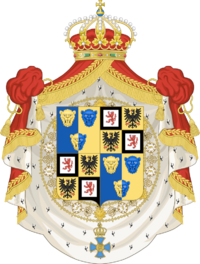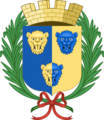Coat of arms of Durland
| Coat of arms of Durland | |
|---|---|
 Greater (royal) version | |
| Versions | |
 Lesser (state) version | |
| Armiger | Carilla, Princess of Durland |
| Adopted | Initially adopted on 14 August 1876. Modified 1877. Readopted 9 April 1928. |
| Torse | tasseled strings Or |
| Blazon | Quarterly, I and IV Per pale Azure and Or btween three leopard heads caboshed all countercharged. II and III Argent a lion rampant Gules within a bordure Sable impaling Or, an eagle displayed sable beaked and membered Gules and Crowned Or. |
| Orders | Order of Prince Jora |
| Other elements | The monarch places this coat of arms on a mantle gules lined with Ermine. Above the mantle is a pavilion gules again topped with the royal crown. |
The coat of arms of Durland is the arms of dominion of Princess Carilla of Durland, and is used to represent both the monarch and the state. The shield quarters the attributed arms of Prince Jora and the House of Leps, representing the state and the ruling house respectively.
The coat of arms is used to represent the authority of the state; the monarch, government, and Supreme Court all use versions of the arms to assert their legitimate authority. The government uses a variation of the arms without mantle or order, which is known as the state arms. Members of the Princely Family maintain their own arms for use in a private capacity.
History
The coat of arms was designed by Prince Farnar II. Farnar, an amateur herald and artist, designed the coat of arms originally on the back of an envelope whilst travelling from Nelin to Alduar en route to Herran. The arms were inspired by those of Prince Jora, Grand Prince of the Durlish Principalities, who reigned from 1527 until 1561. The arms, consisting of a blue and yellow shield bearing three countercharged leopard heads, as well as the arms of the House of Leps, reflects the pre-colonial monarchy and the new princely house respectively.
The coat of arms were formally registered with the Court of Arms in 1876, but were de facto used from their creation a year prior. On the creation of the Order of Prince Jora in 1877, the coat of arms was amended to include the order as a circlet around the escutcheon.
In 1922, following the abolition of the monarchy and the establishment of the Second Durlish Republic, the coat of arms was amended to remove references to the Crown. The new arms featured only the arms of Prince Jora between two golden laurel branches, crowned with a mural crown. Proposals for a wholly new emblem severing all connection with the previous regime were initially made, but never carried through.
On the restoration of the monarchy in 1928, the coat of arms used from 1879-1922 were readopted.
Description
The current coat of arms was adopted in 1928 following the re-establishment of the monarchy. It is closely modelled on the coat of arms previously used from 1878 until 1922. As per the registration with the Court of Arms, the escutcheon is blazoned: Quarterly, I and IV Per pale Azure and Or btween three leopard heads caboshed all countercharged. II and III Argent a lion rampant Gules within a bordure Sable impaling Or, an eagle displayed sable beaked and membered Gules and Crowned Or. The shield is surrounded by the insignia of the Order of Prince Jura, and all surrounded by mantling Gules doubled ermine, crowned with the royal crown and tied up with tassled strings Or.
The rules outlining the design and use of the coat of arms, including variations and eligibility, continue to be based on those made by Farnar II.
Usage
The proper use of the Durlish coat of arms is regulated by law. The National Sybols Act 2003, which updated and consolidated existing legislation relating to the coat of arms, identifies three types of arms used in Durland: the great coat of arms, the state coat of arms, and the shield of arms (or escutcheon).
- The great coat of arms is the arms of dominion of the Durlish monarch, and subsequently serves as the coat of arms of the Sovereign Prince(ss) and also of the state. It is used to represent the Crown and the nation.
- The state coat of arms is the arms used by the government and government entities. It is used to denote a relationship with the state and, in a broader sense, ownership and oversight by the government.
- The shield of arms is the general design of the escutcheon, as used in either the great or state coat of arms or as part of the personal arms of individuals.
The distinction between the great coat of arms and the state coat of arms is not clearly made. The great coat of arms generally represents the monarch and non-executive state institutions (e.g., Parliament, the courts, the armed forces etc.), whereas the state coat of arms represents the government and state. The Durlish passport, as government property, uses the state arms.
Variants
Royal versions
Gallery
- Coats of arms of the Monarch
- Coats of arms of members of the Princely House
- Coat of arms of members of the Princely Family and other variants
















